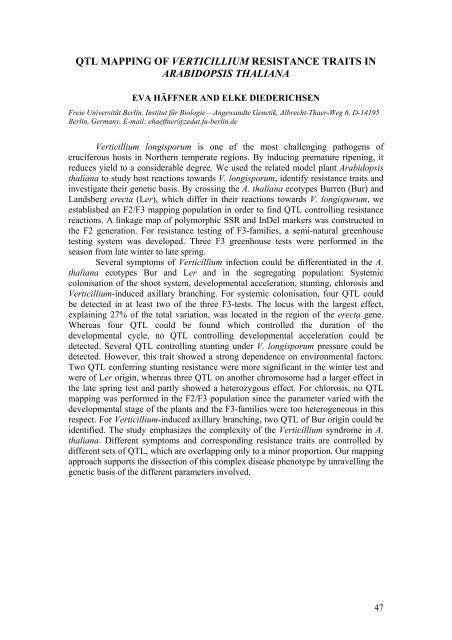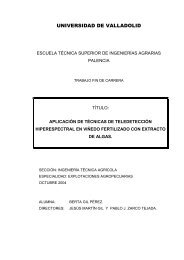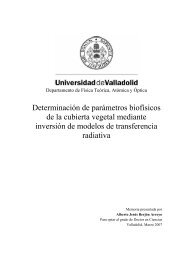10th INTERNATIONAL VERTICILLIUM SYMPOSIUM 16-20 ...
10th INTERNATIONAL VERTICILLIUM SYMPOSIUM 16-20 ...
10th INTERNATIONAL VERTICILLIUM SYMPOSIUM 16-20 ...
Create successful ePaper yourself
Turn your PDF publications into a flip-book with our unique Google optimized e-Paper software.
QTL MAPPING OF <strong>VERTICILLIUM</strong> RESISTANCE TRAITS INARABIDOPSIS THALIANAEVA HÄFFNER AND ELKE DIEDERICHSENFreie Universität Berlin, Institut für Biologie – Angewandte Genetik, Albrecht-Thaer-Weg 6, D-14195Berlin, Germany, E-mail: ehaeffner@zedat.fu-berlin.deVerticillium longisporum is one of the most challenging pathogens ofcruciferous hosts in Northern temperate regions. By inducing premature ripening, itreduces yield to a considerable degree. We used the related model plant Arabidopsisthaliana to study host reactions towards V. longisporum, identify resistance traits andinvestigate their genetic basis. By crossing the A. thaliana ecotypes Burren (Bur) andLandsberg erecta (Ler), which differ in their reactions towards V. longisporum, weestablished an F2/F3 mapping population in order to find QTL controlling resistancereactions. A linkage map of polymorphic SSR and InDel markers was constructed inthe F2 generation. For resistance testing of F3-families, a semi-natural greenhousetesting system was developed. Three F3 greenhouse tests were performed in theseason from late winter to late spring.Several symptoms of Verticillium infection could be differentiated in the A.thaliana ecotypes Bur and Ler and in the segregating population: Systemiccolonisation of the shoot system, developmental acceleration, stunting, chlorosis andVerticillium-induced axillary branching. For systemic colonisation, four QTL couldbe detected in at least two of the three F3-tests. The locus with the largest effect,explaining 27% of the total variation, was located in the region of the erecta gene.Whereas four QTL could be found which controlled the duration of thedevelopmental cycle, no QTL controlling developmental acceleration could bedetected. Several QTL controlling stunting under V. longisporum pressure could bedetected. However, this trait showed a strong dependence on environmental factors.Two QTL conferring stunting resistance were more significant in the winter test andwere of Ler origin, whereas three QTL on another chromosome had a larger effect inthe late spring test and partly showed a heterozygous effect. For chlorosis, no QTLmapping was performed in the F2/F3 population since the parameter varied with thedevelopmental stage of the plants and the F3-families were too heterogeneous in thisrespect. For Verticillium-induced axillary branching, two QTL of Bur origin could beidentified. The study emphasizes the complexity of the Verticillium syndrome in A.thaliana. Different symptoms and corresponding resistance traits are controlled bydifferent sets of QTL, which are overlapping only to a minor proportion. Our mappingapproach supports the dissection of this complex disease phenotype by unravelling thegenetic basis of the different parameters involved.47




